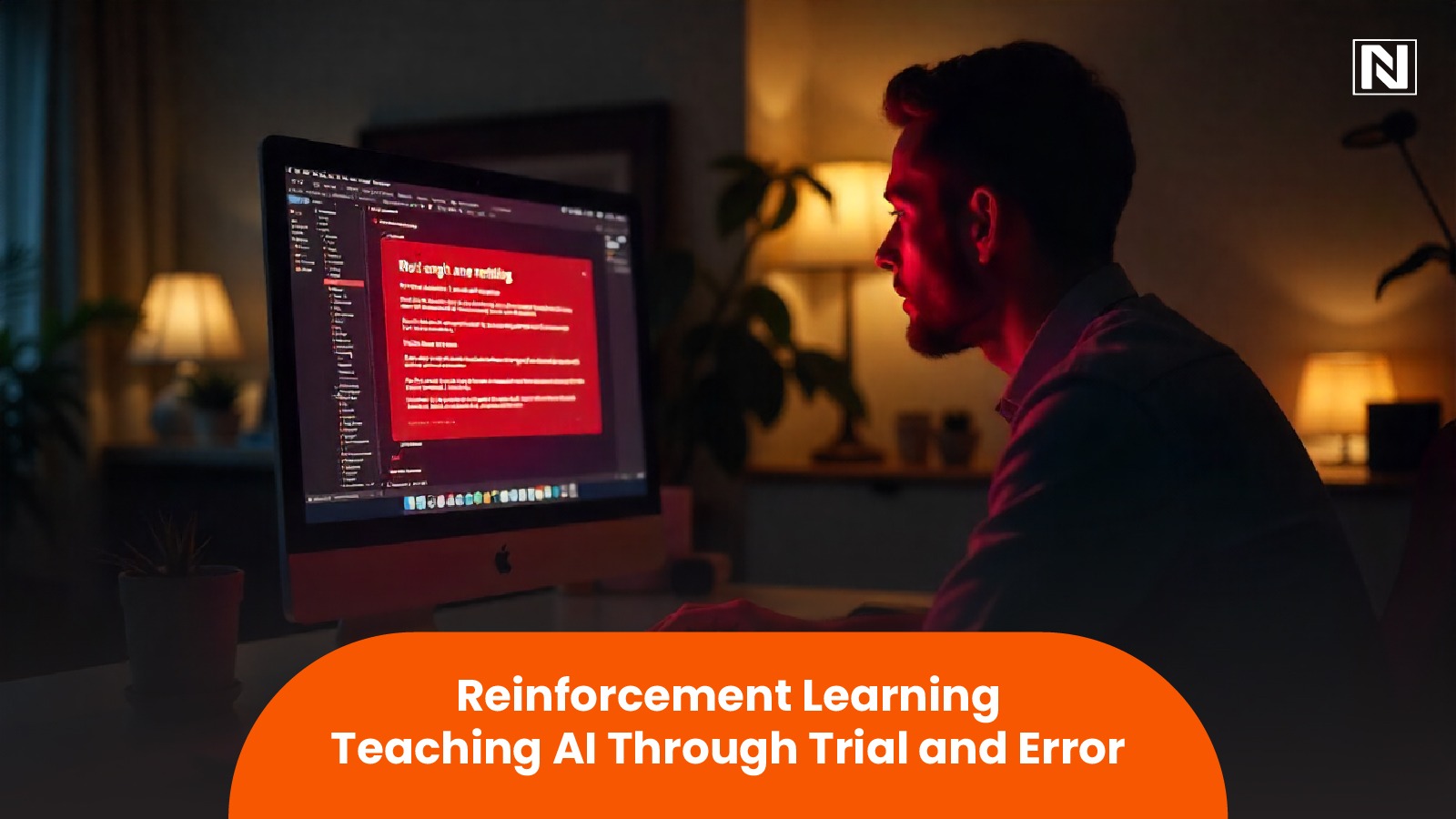
Artificial Intelligence has progressed through various learning paradigms, including supervised learning, unsupervised learning, and, most recently, reinforcement learning. Among these, reinforcement learning (RL) is unique because it doesn’t rely solely on labeled data or static patterns.
Instead, it mimics how humans and animals learn: by trial, error, and reward. This is the backbone behind some of the most exciting AI breakthroughs in robotics, gaming, autonomous systems, and decision-making engines.
Let’s break down what makes reinforcement learning so powerful, how it works, and why 2025 is shaping up to be a defining year for this field.
What Reinforcement Learning Really Means
At its core, reinforcement learning is about training an agent to interact with an environment in order to achieve a goal. The agent performs actions, receives feedback in the form of rewards or penalties, and adjusts its behavior over time. This cycle of action and feedback is what people mean when they say AI trial and error learning.
Unlike supervised learning where models get the “right answer” upfront, reinforcement learning basics are messier. The system explores different strategies, fails often, and eventually discovers what works best. Think of how a toddler learns to walk. They don’t read instructions. They stumble, fall, correct, and repeat until balance becomes second nature. That’s essentially how reinforcement learning works.
DID YOU KNOW?
The Reinforcement Learning Market is anticipated to expand at a CAGR of 32.9%, rising from $7.88 billion in 2025 to $57.7 billion by 2032.
How Reinforcement Learning Works
To understand reinforcement learning for beginners, it helps to visualize the framework:

- Agent: The decision maker (the AI).
- Environment: The world the agent interacts with.
- Actions: The choices available to the agent.
- State: The current situation or context the agent observes.
- Reward: Feedback from the environment based on the agent’s action.
Every step is about balance: exploration versus exploitation. Should the agent try something new (explore) or double down on what has worked before (exploit)? The best strategies often combine both.
A classic example is training an AI to play chess. It starts by making random moves, loses almost all games, but with each round it learns which actions increase the likelihood of winning. Over millions of iterations, the model evolves into a near-perfect strategist.
A MUST READ – AI vs ML vs Deep Learning: What’s the Difference?
Why Businesses Should Care
For business leaders, it represents a practical path to smarter automation and long-term efficiency. Imagine logistics systems that continuously refine delivery routes, trading algorithms that adapt to volatile markets, or customer service bots that improve with every interaction.
What this really means is reinforcement learning is not just about AI research anymore, it’s moving into enterprise adoption.
Reinforcement Learning Trends 2025
So what’s new and emerging in this space? A few trends are worth highlighting:
1. Scalable RL for enterprises
In 2025, companies are investing in RL systems that can handle dynamic, large-scale environments, from global supply chains to industrial IoT.
2. Safer exploration methods
One of the challenges of RL is the cost of mistakes. New research is focusing on how to minimize harmful trial and error, which is critical for sectors like healthcare and autonomous driving.
3. RL meets LLMs
Reinforcement learning is being paired with large language models (LLMs) to improve decision-making. For example, LLMs can generate options, and RL can evaluate them against long-term outcomes.
4. Low-resource RL
Historically, RL required massive compute power. Now, more efficient algorithms are making it accessible for mid-size organizations without hyperscale infrastructure.
5. Human-in-the-loop reinforcement learning
To reduce bias and improve safety, human feedback is being blended into RL systems. This hybrid approach accelerates learning while maintaining oversight.
These trends show that reinforcement learning is moving from niche applications to mainstream AI strategy.
You Cannot Miss It – How to Build A Machine Learning Model (Step-by-Step Guide)
The Technical Challenges
For developers digging into reinforcement learning basics, the math and algorithms can get complex quickly. Popular approaches include:
- Q-Learning: A value-based method where the agent learns the expected reward for each action in a given state.
- Policy Gradients: Directly optimizing the decision policy using gradient-based methods.
- Actor-Critic Models: Combining value-based and policy-based methods for more stability.
But here’s the thing: RL isn’t plug-and-play. It requires carefully designing the reward function, tuning hyperparameters, and ensuring the environment is a good simulation of real-world dynamics. A poorly designed reward function can cause unintended behaviors like an AI that learns to exploit loopholes rather than solve the intended problem.
Reinforcement Learning for Beginners: Where to Start
If you’re new to RL, the best approach is hands-on experimentation. OpenAI Gym, Stable Baselines, and RLlib are common frameworks to get started. Begin with simple environments like training an agent to balance a cartpole before moving to more complex tasks like robotics or finance simulations.
A few guiding principles:
- Don’t skip theory: Understanding Markov Decision Processes (MDPs) is critical.
- Reward shaping matters: The way you design feedback defines the behavior you’ll get.
- Patience is key: RL agents often need millions of iterations. Cloud computing or GPU acceleration is almost mandatory.
Where Reinforcement Learning Is Winning Today
Some standout applications already making a business impact:
- Autonomous vehicles: RL is used for motion planning and decision-making under uncertainty.
- Energy management: Data centers use RL to optimize cooling systems and reduce power consumption.
- Healthcare: RL supports personalized treatment recommendations by simulating patient responses.
- Finance: Trading systems leverage RL to adapt to changing market dynamics in real time.
- Robotics: Robots trained with RL can perform complex manipulation tasks that were previously hard to program manually.
These use cases highlight why reinforcement learning is becoming a key lever for industries seeking adaptability and resilience.
Looking Ahead
As reinforcement learning trends in 2025 continue to mature, expect two major shifts:
- Wider adoption across industries: Not just tech giants, but manufacturing, retail, logistics, and healthcare will start embedding RL into everyday operations.
- Greater accessibility: With open-source tools, better simulation platforms, and cloud-native RL pipelines, the barrier to entry is lower than ever.
For business decision makers, it’s a moment to rethink how adaptive intelligence can transform operations and unravel competitive advantage.
Final Thoughts
Reinforcement learning is not a magic wand, but it’s a powerful way of teaching AI through trial and error. It forces us to rethink traditional training methods, emphasizing exploration, feedback, and incremental progress. For developers, it’s an intellectually challenging but rewarding field. For businesses, it’s a pathway to building systems that don’t just execute rules but learn, adapt, and improve continuously.
If you’re evaluating where AI fits in your roadmap, keep reinforcement learning on your radar. The breakthroughs happening now will likely shape the competitive orbit for years to come.
Frequently Asked Questions
What is reinforcement learning (RL)?
Reinforcement learning is an AI training method where an agent learns by interacting with an environment, receiving rewards or penalties for actions, and improving its strategy over time through trial and error.
How does reinforcement learning differ from supervised learning?
Unlike supervised learning (which relies on labeled data), RL learns through exploration and feedback (no predefined “correct” answers are given). The AI discovers optimal actions by maximizing rewards.
What are some real-world applications of reinforcement learning?
Key applications include autonomous vehicles, robotics, financial trading algorithms, energy optimization, healthcare treatment planning, and adaptive customer service bots.
What are the major challenges in reinforcement learning?
Challenges include designing effective reward functions, ensuring safe exploration, high computational costs, and avoiding unintended behaviors due to poorly defined rewards.
How can beginners start with reinforcement learning?
Beginners should:
- Learn fundamentals (Markov Decision Processes, reward shaping).
- Use frameworks like OpenAI Gym or RLlib.
- Start with simple tasks (e.g., cartpole balancing) before advancing to complex simulations.
